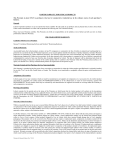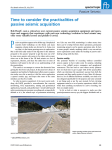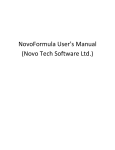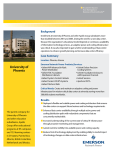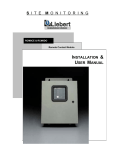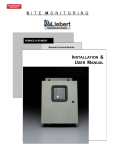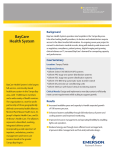Download Emerson Liebert XD Pumping and Chiller Units Case Studies
Transcript
A Customer Success from the Experts in Business-Critical Continuity™ Background HESS increasingly depends on technology to support oil exploration and production. When the company first transitioned from mainframe to blade server technology for its most intense processing tasks, the raised floor system provided adequate but limited cooling. When HESS added a second blade server cluster, data center managers saw that they needed a more flexible and scalable approach to cooling. Case Summary HESS Corporation Location: Houston, Texas Products/Services: •Liebert XDO Overhead Fan Coils •Liebert XDC Chiller •Liebert Deluxe Precision Air Conditioners •Liebert Series 600 and Liebert Series 610 UPS •Liebert PPC Precision Power Centers •Liebert SiteScan Web HESS Corporation is a leading global independent energy company engaged in the Critical Needs: Support uninterrupted operation of expanding high-performance computing center performing geophysical modeling for petroleum exploration. exploration and production of crude oil and natural gas, as well as in refining and selling refined petroleum products, natural gas, and electricity. Headquartered in New York, the company has operations in the United States, United Kingdom, Norway, Denmark, Equatorial Guinea, Gabon, Azerbaijan, Thailand and Indonesia. It produces more than 350,000 barrels of oil annually. Results Temperature maintained at a stable 60 degrees in a zone containing 1,000 Dell PowerEdge Energy Smart Servers. Flawless performance of power and cooling infrastructure delivers 100 percent uptime. Real-time data from comprehensive monitoring solution enables preventive maintenance and proactive planning for future changes. A Customer Success from the Experts in Business-Critical Continuity™ The Situation With a goal of replacing 100 percent of its petroleum reserves annually, HESS directs more than 95 percent of its total capital expenditures to exploration, development and production activities. After evaluating hundreds of opportunities, the company drills approximately 15 oil wells per year. Traditionally a high-stakes guessing game, oil exploration today uses technology to improve the odds of success. At its Houston, Texas, offices, HESS maintains a 20,000-square-foot data center servicing the seismic processing needs of its global exploration and production operation. This data center processes huge amounts of raw seismic data, collected worldwide, to help determine the presence and location of oil deposits. Creating the three-dimensional models used by geoscientists to find oil and gas in hard-to-reach underwater areas requires massive computing power. At any given time, the data center processes 1,500 Terabytes (TB) of active data via Linux clusters operating on blade-server arrays. The company’s processing needs have grown by 25 percent per year for the past few years, and managers expect similar growth in the years to come. The data center’s computer hardware evolved rapidly from large mainframes only a few years ago to today's distributed arrays of 1,000 blade servers. This increased computing capacity supports more precise modeling of geological formations and increased accuracy in identifying potential oil and gas deposits. The continued evolution of the hardware requires an equally dynamic support infrastructure. “People often underestimate the power and cooling demands of high-density equipment. Those 1,000 blade servers draw 360 kW of power and put out 104 tons of heat in 2,000 square feet.” Michael Musgrove, supervisor of Computer Operations, HESS’s Exploration & Production Division “I always have to be prepared for change,” says Michael Musgrove, supervisor of Computer Operations for HESS’s Exploration & Production division. “We could decide tomorrow that we need to add another 1,000-server array.” As with many data center managers, Musgrove was caught somewhat off guard by blade servers’ heat output. “The vendors of these high-density servers don’t always tell you up front how much heat they really kick out and how much power they draw,” he says. “It’s been a learning curve.” When HESS installed its first supercomputing cluster, Musgrove attempted to turbo-charge his existing raised floor cooling systems. “We installed Plexiglas A Customer Success from the Experts in Business-Critical Continuity™ at the ends of the cold aisles to seal them off and used under-floor fans to force cold air into the enclosed space,” he says. Although it performed adequately, Musgrove found that this approach had drawbacks. “It placed too much strain on the floor-mount precision cooling units, which weren’t designed to handle the intense, localized heat loads of high-density blade servers,” he says. “The inefficiency of relying strictly on floor-mount cooling to cool hot zones added significantly to the electrical power draw and costs of operating the data center in Houston’s blazing heat and high humidity. “And, the temperature wasn’t completely uniform—it comes in at about 54 degrees at the floor, but rises to about 70 by the time it reaches the ceiling.” Naturally, this posed significant threats to the operation and lifespan of blade servers at the top of the racks. When the time came to add a second, 1,000-server cluster in 2006, Musgrove called on local Liebert Representatives from Emerson Network Power to recommend a dynamic and scalable high-density infrastructure that would meet HESS’ computing demands. The Solution After conducting air-flow modeling tests on the entire data center, Liebert representatives from Bud Griffin & Associates recommended supplementing existing under-floor cooling with the Liebert XD family of extreme density cooling solutions, which would bring a high-density cooling solution closer to the source of the heat. The Liebert XD family provides a flexible, scalable and waterless solution that delivers sensible cooling of “The system has done exactly what we expected it to do. It keeps the equipment at a safe temperature, which keeps it running, and that keeps our geosciences group happy.” Michael Musgrove, supervisor of Computer Operations, HESS’s Exploration & Production Division more than 500 Watts per square foot. Liebert XD modules use an environmentally friendly, pumped refrigerant to achieve high efficiencies. The refrigerant is pumped as a liquid, converts to a gas within the heat exchangers and then is returned to the pumping station where it is re-condensed to liquid. A combination of Liebert XD supplemental cooling with room-level cooling can reduce cooling-related energy costs by 25 to 30 percent compared to room cooling alone. For example, a 45-ton traditional floor-mount precision cooling system requires 15 to 18 hp to operate its evaporator fan motors. By contrast, each Liebert XD unit uses a 1⁄ 2-hp fan, for a savings of 10 to 13 hp and a corresponding decrease in the heat load generated by that working horsepower. A Customer Success from the Experts in Business-Critical Continuity™ The new cluster has its own high-density zone in the data center, with 20 racks arranged in two rows and positioned front-to-front to create a cold aisle between the rows. Each rack contains 50 Dell PowerEdge Energy Smart Servers configured with dual processors, which draw 18 kW of power per rack. “People often underestimate the power and cooling demands of high-density equipment,” Musgrove says. “Those 1,000 blade servers draw 360 kW of power and put out 104 tons of heat in 2,000 square feet.” In the HESS data center, 10 ceiling-mounted Liebert XDO cooling modules, rated at16 kW each, supplement the cold air being delivered through the raised floor by 10 Liebert Deluxe precision air conditioning units. The Liebert Deluxe units also provide humidity control and air filtration for the space. A 45-ton Liebert XDC Refrigerant Chiller connects to the cooling modules via the pumped refrigerant circuit and to the roof-top heat rejection units via direct expansion refrigerant circuits. The Liebert power system at HESS easily expanded to handle the additional equipment. The addition of a 750 kVA Liebert UPS to an existing 500 kVA Liebert Series 610 UPS provides at least 20 minutes of clean, reliable backup power in the event of a power loss. Ten Liebert PPC Precision Power Centers provide power isolation, distribution, and computer-grade grounding. The facility will soon add a 1.25 MW backup generator to ensure continual operation in the face of increasing hurricane activity and often unreliable utility power. Always-On Analysis With the increase in availability demands of the new computing cluster came a corresponding increase in the cost of downtime. To reduce the risk, HESS installed Liebert SiteScan Web, an enterprise-wide monitoring solution that displays the status of all “My Liebert equipment gives me one less thing to worry about. You can't put a price tag on peace of mind, especially in an operation as complex and as critical as ours.” Michael Musgrove, supervisor of Computer Operations (right), HESS’s Exploration & Production Division Tim Bircher (left), Bud Griffin & Associates critical support systems from any internal computer, allowing staff to quickly ascertain the status of the critical power and cooling systems. Among other abilities, Liebert SiteScan Web assembles performance data from the Liebert XD and Liebert Deluxe precision cooling systems. It also collects data from the Liebert PPC Precision Power Centers that allow managers to monitor the electrical load in real time. Data analysis and trend reporting capabilities allow Musgrove and his team to identify and correct problems before they affect operations. In addition, programmable alarm and event management functions indicate when operating conditions fall outside of set parameters, allowing time to correct issues before they trigger cooling and power system failure. A Customer Success from the Experts in Business-Critical Continuity™ For example, if utility power failure causes the UPS to switch to battery backup but the generator fails because of overload, SiteScan Web will send alerts to appropriate personnel, allowing an operator to shed non-critical loads and re-start the generator before battery backup time is exhausted. Later, data center personnel can examine SiteScan Web’s historical trending and analysis to determine why the generator failed to start and can correct the issue so that it does not occur again in the future. “With this room, I need extra security, and SiteScan Web provides it,” Musgrove says. “We haven't experienced any downtime since it was installed, but it has alerted us to conditions that, if uncorrected, could have taken us offline.” Since installation was complete in March 2006, the Liebert XD system has delivered on high expectations. “The system has done exactly what we expected it to do,” Musgrove says. “It keeps the equipment at a safe temperature, which keeps it running, and that keeps our geosciences group happy.” The scalability inherent in the Liebert XD solution also gives HESS the option to add additional high-density computing equipment as needed without retrofitting the entire data center. “If we need to add another 1,000-server computing array tomorrow, one of my first calls would be to Bud Griffin & Associates,” Musgrove says. “The plug-and-play nature of the Liebert XD system allows me to expand on demand.” As HESS adds new equipment to the data center, Liebert SiteScan will adapt to monitor the new technologies. And, Musgrove maintains active service contracts with Emerson Network Power to maintain the power and cooling infrastructure. Musgrove believes he has found a trusted resource for delivering the system availability demanded by this critical research group. “My Liebert equipment gives me one less thing to worry about. You can't put a price tag on peace of mind, especially in an operation as complex and as critical as ours.” The Results For more information on Liebert technology, visit www.Liebert.com. HESS now has a dynamic power and cooling infrastructure that delivers a high degree of flexibility without compromising availability. Emerson Network Power. The global leader in enabling Business-Critical Continuity™. EmersonNetworkPower.com AC Power Embedded Computing Outside Plant Racks & Integrated Cabinets Connectivity Embedded Power Power Switching & Control Services DC Power Monitoring Precision Cooling Surge Protection While every precaution has been taken to ensure accuracy and completeness in this literature, Liebert Corporation assumes no responsibility, and disclaims all liability for damages resulting from use of this information or for any errors or omissions. Specifications subject to change without notice. © 2007 Liebert Corporation. All rights reserved throughout the world. Trademarks or registered trademarks are property of their respective owners. ® Liebert and the Liebert logo are registered trademarks of the Liebert Corporation. Business-Critical Continuity, Emerson Network Power and the Emerson Network Power logo are trademarks and service marks of Emerson Electric Co. © 2007 Emerson Electric Co. 0807





